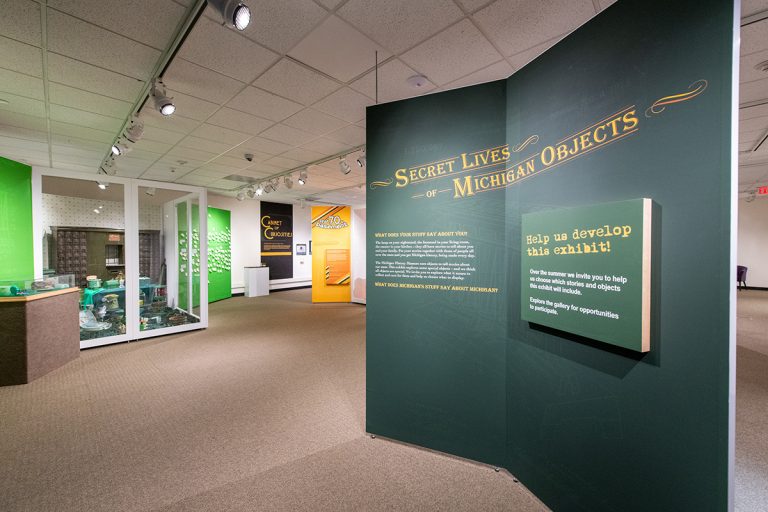Careless Handling
Careless handling is one of the main causes of damage to objects. When moving things that are important to you, consider using foam or another form of padding when moving these objects. At the Michigan History Center, we put items on cart and roll them from place to place. Humans can be clumsy, and accidents happen, but if you trip while carrying something that is precious to you, the outcome could be devastating.
It is also important to consider how old an item is, and how age and use may have weakened the object over time. For example, we never pick things up by their handles! Since they were used so much during the objects’ use-life, handles are generally the weakest point of an artifact.
Improper Storage
Have you heard that the worst place to store valuables is in the artic or the basement? That’s because a proper environment is needed in storage. In general, you want conditions that contain low light levels, limited exposure, moderate temperature, stable relative humidity above 25% and below 55%, and clean air.
When packing objects for storage, they should be completely covered. No part of the object should protrude from the box, file folder, drawer, or cover. Soft items should be padded to avoid sharp folds. Items should be fully supported and not allowed to hang over edges.
All items should be raised four to six inches off the floor for cleaning and for protection from leaks and minor floods. Object storage containers should be very clearly labeled so one does not have to open and unpack items to find things.
Inappropriate Packing Materials
Something you might find surprising is that storage materials like boxes, bins and paper can contain chemicals and other agents that contribute to the deterioration of artifacts. If you have ever scrapbooked or put together a photo album, you’ve seen the words splashed all over packaging: acid free! This is because conventional papers and cardboard contain acids that, while not harmful to humans, can cause paper, photographs and other organic materials to decompose over time.
There is a term in museum collections called “off-gassing.” You know that “new car smell?” Or the smell of a freshly painted room? That smell is the result of off-gassing. It is when finishes, paint, glue, and other substances emit chemical particles. These particles are called VOCs, or volatile organic compounds, and like paper acid, they can degrade and destroy other materials that are stored in and around them. Most plastics, including items made of vinyl and PVC, release chemicals that can damage nearby items.
I bet we’ve all heard that cedar chests and closets are the ideal place to store important textiles and heirlooms. These chest and closets were thought to be good because they seemed to help reduce the likelihood of pest infestation in woolen and silk items. But I have bad news: cedar does not kill any pests. Its aromatic gases are simply irritating for pests and make them less likely to stay in the vicinity for a prolonged period. The gasses emitted by cedar, some of which make it smell so good, are very acidic and cause deterioration, dark discoloration along the edges of folded items, and embrittlement of organic materials like quilts and linens.
How to Fight Secret Agent Breakage
Proper Handling: An easy way to fight breakage is – you guessed – to handle your objects properly. As we’ve discussed, materials naturally degrade over time. The handle on that old steamer trunk you love was probably used heavily over its lifetime, and, as a result, is the most likely place where degradation will start to occur. Lifting the trunk by those handles could easily break them, resulting in unintentional damage.
The same is true for ceramics, like teacups and pitchers. The most delicate place on these items are, yes you guessed it, the handles. If you want to avoid accidentally snapping them off, hold from the bottom and never by the handle.
Even heavy pieces of furniture are susceptible to handling damage. Wood joints in old dining chairs, for example, can become loose. By lifting from the top, they can dislodge and cause the furniture to fall apart. To avoid this, lift chairs by their seats, or wherever you determine is the most solid place.
Proper Storage: Museums rely on storage boxes, padding and batting that are manufactured by companies like Gaylord, because they have done all the leg work in ensuring that VOCs are not present in their materials. You too can enjoy the benefits of museum-quality storage products – check out their catalog. University Products, Hollinger, and Talas also offer such products.
Proper Protection: For some materials, like metals, silks, and papers, handling them with bare hands can also cause damage. The oils and dirt present on our hands can stain, and even chemically interact with, the objects we want to preserve. A single fingerprint on a silver teapot can, if not wiped off immediately, literally etch itself into the metal. All the polishing in the world can’t remove that stain.
When handling these items, it is best to put a barrier between your skin and the object, usually with gloves. Nitrile are the current preferred method, because they have low resistance to friction, are easy to slide on, have a higher degree of flexibility, and are solvent resistant.


